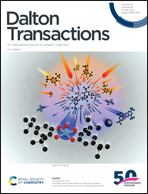Tuning metal to metal charge transfer properties in cyanidometal-bridged complexes by changing the auxiliary ligand on the bridge†
Abstract
In order to investigate the influence of the auxiliary ligand of the cyanidometal bridge on metal to metal charge transfer (MMCT) in cyanidometal-bridged complexes, two groups of heterotrimetallic cyanidometal-bridged complexes, trans-[Cp*(dppe)Fe-NC-Ru(L)2-CN-Fe(dppe)Cp*][PF6]n (L = bpy, 1(PF6)n; L = 4,4′-dmbpy, 2(PF6)n; n = 2, 3, 4) (Cp* = 1,2,3,4,5-pentamethylcyclopentadiene, dppe = 1,2-bis(diphenylphosphino)ethane, bpy = 2,2′-bipyridine, 4,4′-dmbpy = 4,4′-dimethyl-2,2′-bipyridyl) were synthesized and fully characterized. The MMCT of the one-electron oxidation mixed valence complexes is mainly attributed to RuII and FeII → FeIII MMCT transitions, and the MMCT of the two-electron oxidation complexes is mainly attributed to RuII → FeIII MMCT transitions. The energy of the MMCT of the four complexes decreases with the increase of the electron donating ability of the auxiliary ligand of the cyanidometal bridge. The IR, EPR, and Mössbauer spectra, and the solvent independence of MMCT characterizations indicate that the one-electron oxidation mixed valence complexes may belong to Class II–III systems, and the two-electron oxidation complexes may be localized at low temperature but delocalized at room temperature on the EPR timescale.



 Please wait while we load your content...
Please wait while we load your content...